Primary Healthcare in the UK: Health Inequalities, Nurses, and Culture
VerifiedAdded on 2022/08/25
|13
|2844
|22
Report
AI Summary
This report provides a detailed overview of primary healthcare in the UK, examining the national framework and its role within the NHS. It addresses the evidence of health inequalities across different demographics, including gender, race, and socioeconomic status, and discusses the social determinants of health impacting the UK population. The study explores epidemiological and health inequalities, emphasizing the importance of understanding these factors in nursing practices. Furthermore, it highlights the critical role of nurses in promoting health equality, cultural competence in primary healthcare settings, and the impact of cultural beliefs on patient care. The report also touches upon the challenges faced by the healthcare system, such as an aging population and workforce retention, and suggests strategies for improvement and promoting social justice within the healthcare system.

Primary Healthcare : UK
Student’s details
Student’s details
Paraphrase This Document
Need a fresh take? Get an instant paraphrase of this document with our AI Paraphraser
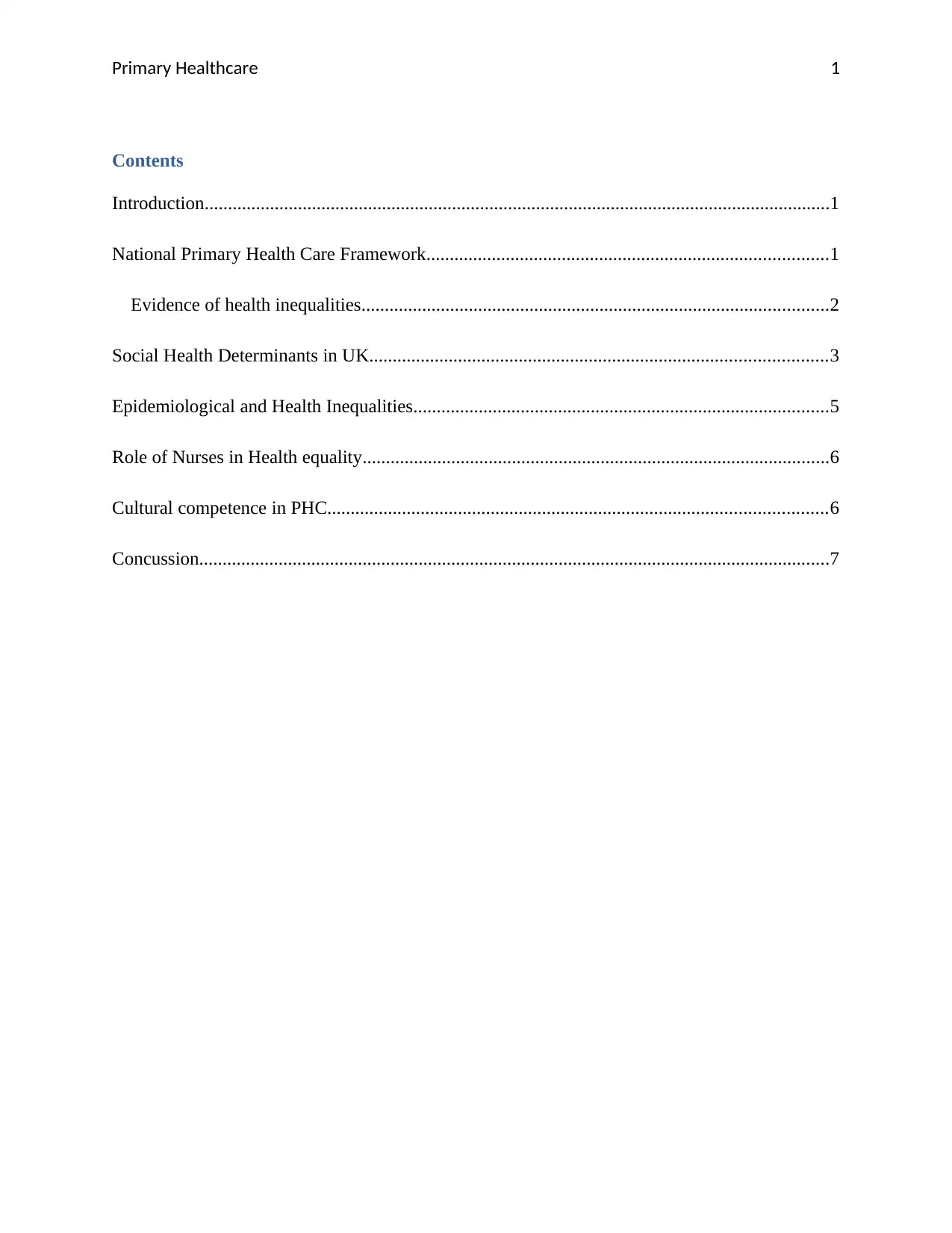
Primary Healthcare 1
Contents
Introduction......................................................................................................................................1
National Primary Health Care Framework......................................................................................1
Evidence of health inequalities....................................................................................................2
Social Health Determinants in UK..................................................................................................3
Epidemiological and Health Inequalities.........................................................................................5
Role of Nurses in Health equality....................................................................................................6
Cultural competence in PHC...........................................................................................................6
Concussion.......................................................................................................................................7
Contents
Introduction......................................................................................................................................1
National Primary Health Care Framework......................................................................................1
Evidence of health inequalities....................................................................................................2
Social Health Determinants in UK..................................................................................................3
Epidemiological and Health Inequalities.........................................................................................5
Role of Nurses in Health equality....................................................................................................6
Cultural competence in PHC...........................................................................................................6
Concussion.......................................................................................................................................7
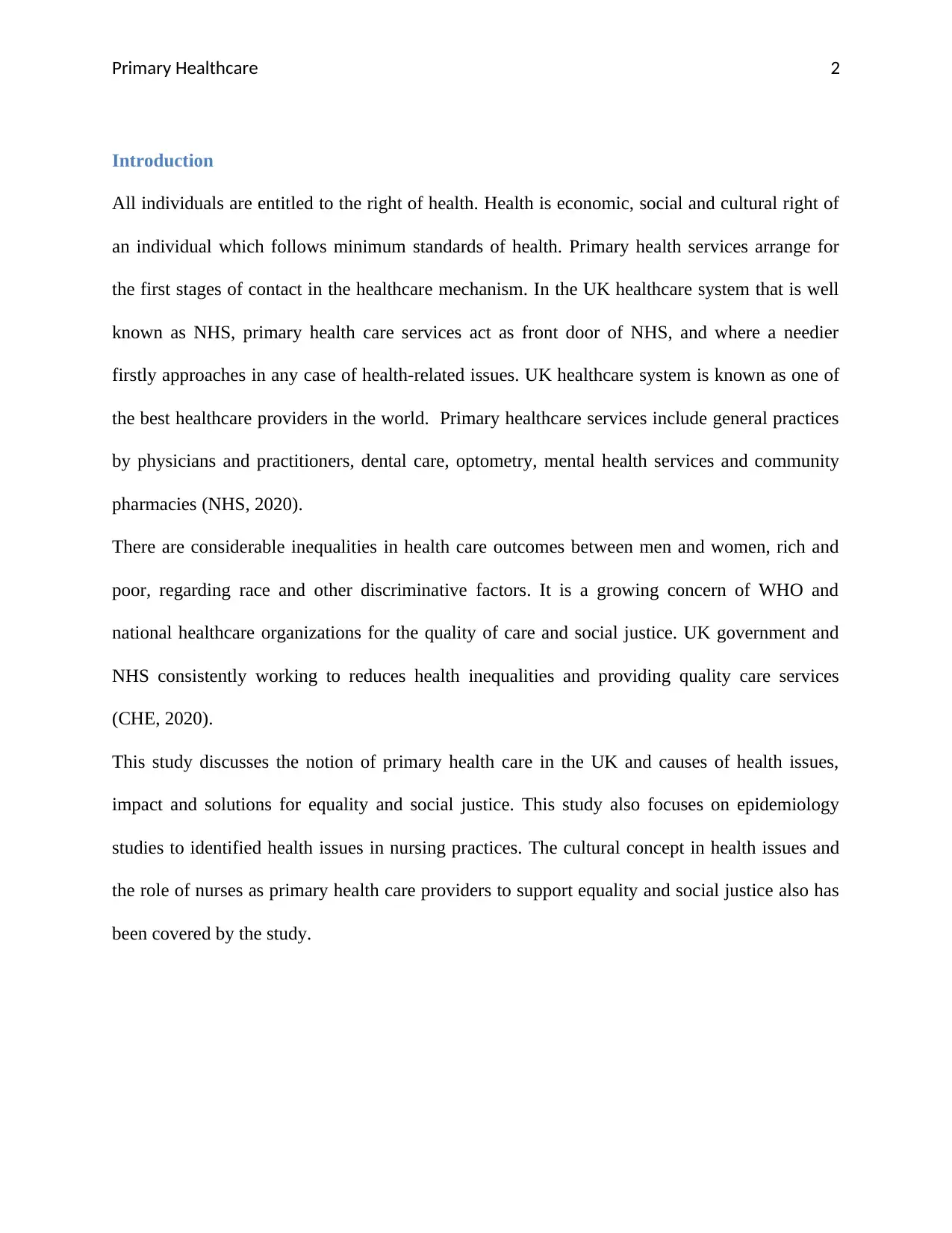
Primary Healthcare 2
Introduction
All individuals are entitled to the right of health. Health is economic, social and cultural right of
an individual which follows minimum standards of health. Primary health services arrange for
the first stages of contact in the healthcare mechanism. In the UK healthcare system that is well
known as NHS, primary health care services act as front door of NHS, and where a needier
firstly approaches in any case of health-related issues. UK healthcare system is known as one of
the best healthcare providers in the world. Primary healthcare services include general practices
by physicians and practitioners, dental care, optometry, mental health services and community
pharmacies (NHS, 2020).
There are considerable inequalities in health care outcomes between men and women, rich and
poor, regarding race and other discriminative factors. It is a growing concern of WHO and
national healthcare organizations for the quality of care and social justice. UK government and
NHS consistently working to reduces health inequalities and providing quality care services
(CHE, 2020).
This study discusses the notion of primary health care in the UK and causes of health issues,
impact and solutions for equality and social justice. This study also focuses on epidemiology
studies to identified health issues in nursing practices. The cultural concept in health issues and
the role of nurses as primary health care providers to support equality and social justice also has
been covered by the study.
Introduction
All individuals are entitled to the right of health. Health is economic, social and cultural right of
an individual which follows minimum standards of health. Primary health services arrange for
the first stages of contact in the healthcare mechanism. In the UK healthcare system that is well
known as NHS, primary health care services act as front door of NHS, and where a needier
firstly approaches in any case of health-related issues. UK healthcare system is known as one of
the best healthcare providers in the world. Primary healthcare services include general practices
by physicians and practitioners, dental care, optometry, mental health services and community
pharmacies (NHS, 2020).
There are considerable inequalities in health care outcomes between men and women, rich and
poor, regarding race and other discriminative factors. It is a growing concern of WHO and
national healthcare organizations for the quality of care and social justice. UK government and
NHS consistently working to reduces health inequalities and providing quality care services
(CHE, 2020).
This study discusses the notion of primary health care in the UK and causes of health issues,
impact and solutions for equality and social justice. This study also focuses on epidemiology
studies to identified health issues in nursing practices. The cultural concept in health issues and
the role of nurses as primary health care providers to support equality and social justice also has
been covered by the study.
⊘ This is a preview!⊘
Do you want full access?
Subscribe today to unlock all pages.

Trusted by 1+ million students worldwide
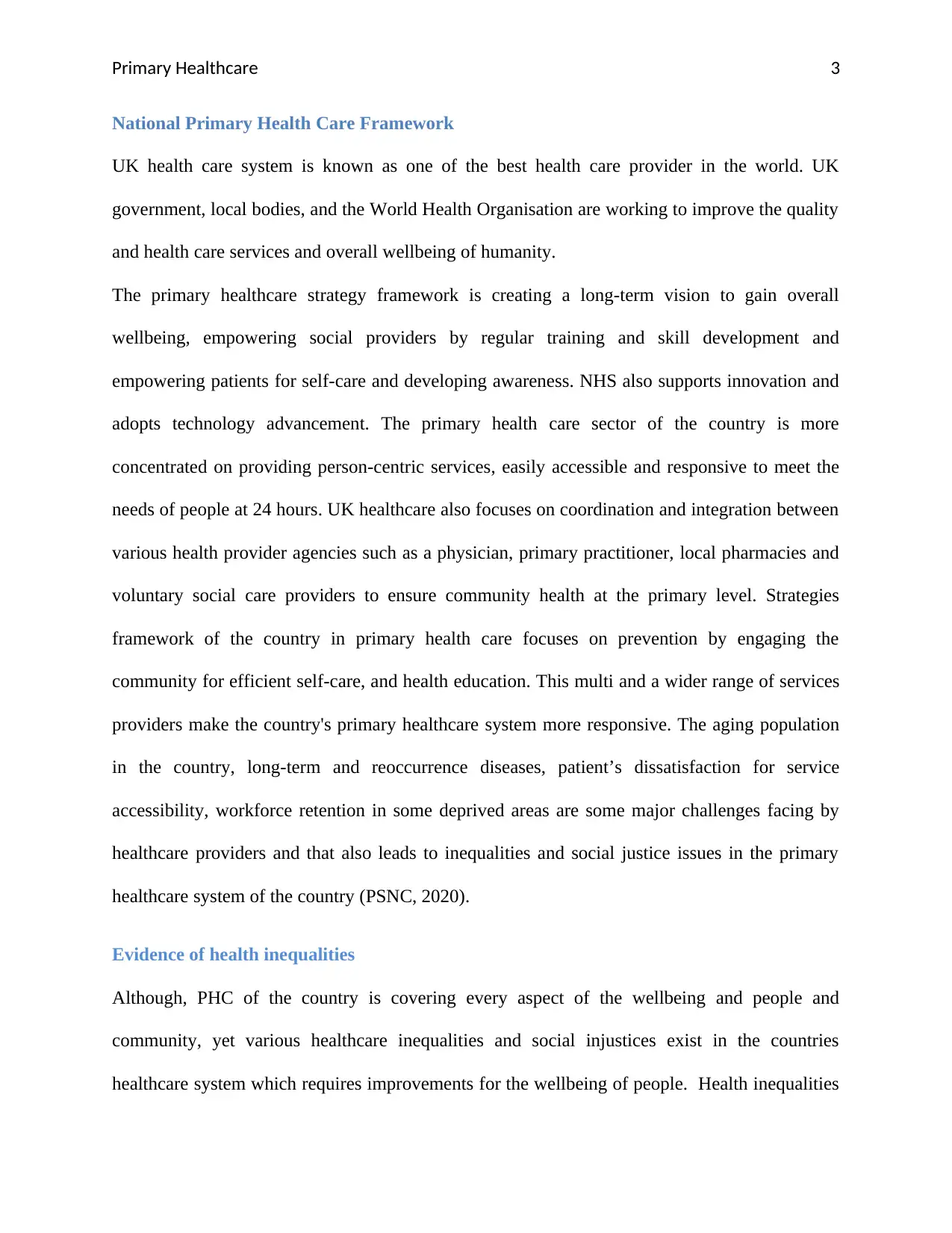
Primary Healthcare 3
National Primary Health Care Framework
UK health care system is known as one of the best health care provider in the world. UK
government, local bodies, and the World Health Organisation are working to improve the quality
and health care services and overall wellbeing of humanity.
The primary healthcare strategy framework is creating a long-term vision to gain overall
wellbeing, empowering social providers by regular training and skill development and
empowering patients for self-care and developing awareness. NHS also supports innovation and
adopts technology advancement. The primary health care sector of the country is more
concentrated on providing person-centric services, easily accessible and responsive to meet the
needs of people at 24 hours. UK healthcare also focuses on coordination and integration between
various health provider agencies such as a physician, primary practitioner, local pharmacies and
voluntary social care providers to ensure community health at the primary level. Strategies
framework of the country in primary health care focuses on prevention by engaging the
community for efficient self-care, and health education. This multi and a wider range of services
providers make the country's primary healthcare system more responsive. The aging population
in the country, long-term and reoccurrence diseases, patient’s dissatisfaction for service
accessibility, workforce retention in some deprived areas are some major challenges facing by
healthcare providers and that also leads to inequalities and social justice issues in the primary
healthcare system of the country (PSNC, 2020).
Evidence of health inequalities
Although, PHC of the country is covering every aspect of the wellbeing and people and
community, yet various healthcare inequalities and social injustices exist in the countries
healthcare system which requires improvements for the wellbeing of people. Health inequalities
National Primary Health Care Framework
UK health care system is known as one of the best health care provider in the world. UK
government, local bodies, and the World Health Organisation are working to improve the quality
and health care services and overall wellbeing of humanity.
The primary healthcare strategy framework is creating a long-term vision to gain overall
wellbeing, empowering social providers by regular training and skill development and
empowering patients for self-care and developing awareness. NHS also supports innovation and
adopts technology advancement. The primary health care sector of the country is more
concentrated on providing person-centric services, easily accessible and responsive to meet the
needs of people at 24 hours. UK healthcare also focuses on coordination and integration between
various health provider agencies such as a physician, primary practitioner, local pharmacies and
voluntary social care providers to ensure community health at the primary level. Strategies
framework of the country in primary health care focuses on prevention by engaging the
community for efficient self-care, and health education. This multi and a wider range of services
providers make the country's primary healthcare system more responsive. The aging population
in the country, long-term and reoccurrence diseases, patient’s dissatisfaction for service
accessibility, workforce retention in some deprived areas are some major challenges facing by
healthcare providers and that also leads to inequalities and social justice issues in the primary
healthcare system of the country (PSNC, 2020).
Evidence of health inequalities
Although, PHC of the country is covering every aspect of the wellbeing and people and
community, yet various healthcare inequalities and social injustices exist in the countries
healthcare system which requires improvements for the wellbeing of people. Health inequalities
Paraphrase This Document
Need a fresh take? Get an instant paraphrase of this document with our AI Paraphraser
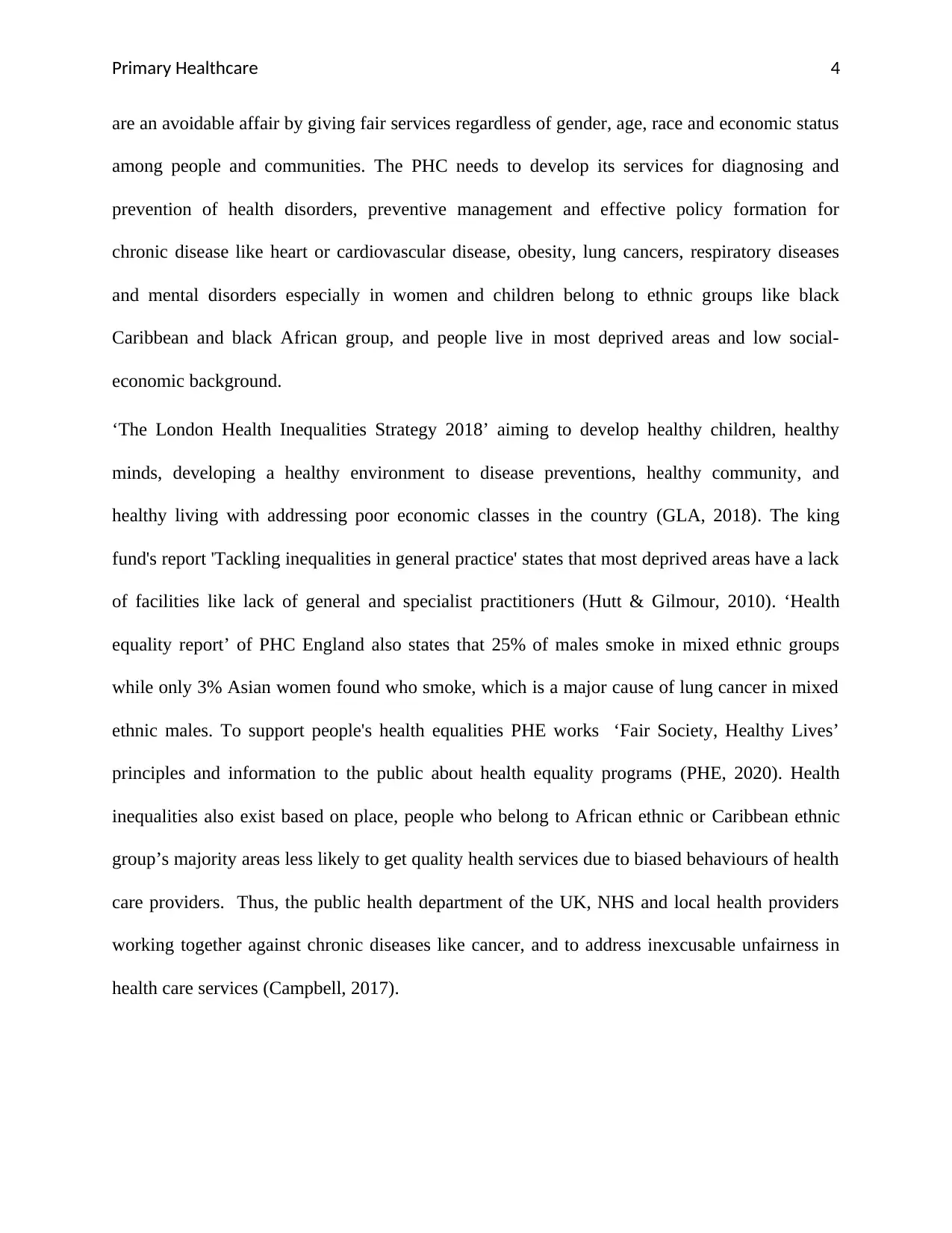
Primary Healthcare 4
are an avoidable affair by giving fair services regardless of gender, age, race and economic status
among people and communities. The PHC needs to develop its services for diagnosing and
prevention of health disorders, preventive management and effective policy formation for
chronic disease like heart or cardiovascular disease, obesity, lung cancers, respiratory diseases
and mental disorders especially in women and children belong to ethnic groups like black
Caribbean and black African group, and people live in most deprived areas and low social-
economic background.
‘The London Health Inequalities Strategy 2018’ aiming to develop healthy children, healthy
minds, developing a healthy environment to disease preventions, healthy community, and
healthy living with addressing poor economic classes in the country (GLA, 2018). The king
fund's report 'Tackling inequalities in general practice' states that most deprived areas have a lack
of facilities like lack of general and specialist practitioners (Hutt & Gilmour, 2010). ‘Health
equality report’ of PHC England also states that 25% of males smoke in mixed ethnic groups
while only 3% Asian women found who smoke, which is a major cause of lung cancer in mixed
ethnic males. To support people's health equalities PHE works ‘Fair Society, Healthy Lives’
principles and information to the public about health equality programs (PHE, 2020). Health
inequalities also exist based on place, people who belong to African ethnic or Caribbean ethnic
group’s majority areas less likely to get quality health services due to biased behaviours of health
care providers. Thus, the public health department of the UK, NHS and local health providers
working together against chronic diseases like cancer, and to address inexcusable unfairness in
health care services (Campbell, 2017).
are an avoidable affair by giving fair services regardless of gender, age, race and economic status
among people and communities. The PHC needs to develop its services for diagnosing and
prevention of health disorders, preventive management and effective policy formation for
chronic disease like heart or cardiovascular disease, obesity, lung cancers, respiratory diseases
and mental disorders especially in women and children belong to ethnic groups like black
Caribbean and black African group, and people live in most deprived areas and low social-
economic background.
‘The London Health Inequalities Strategy 2018’ aiming to develop healthy children, healthy
minds, developing a healthy environment to disease preventions, healthy community, and
healthy living with addressing poor economic classes in the country (GLA, 2018). The king
fund's report 'Tackling inequalities in general practice' states that most deprived areas have a lack
of facilities like lack of general and specialist practitioners (Hutt & Gilmour, 2010). ‘Health
equality report’ of PHC England also states that 25% of males smoke in mixed ethnic groups
while only 3% Asian women found who smoke, which is a major cause of lung cancer in mixed
ethnic males. To support people's health equalities PHE works ‘Fair Society, Healthy Lives’
principles and information to the public about health equality programs (PHE, 2020). Health
inequalities also exist based on place, people who belong to African ethnic or Caribbean ethnic
group’s majority areas less likely to get quality health services due to biased behaviours of health
care providers. Thus, the public health department of the UK, NHS and local health providers
working together against chronic diseases like cancer, and to address inexcusable unfairness in
health care services (Campbell, 2017).
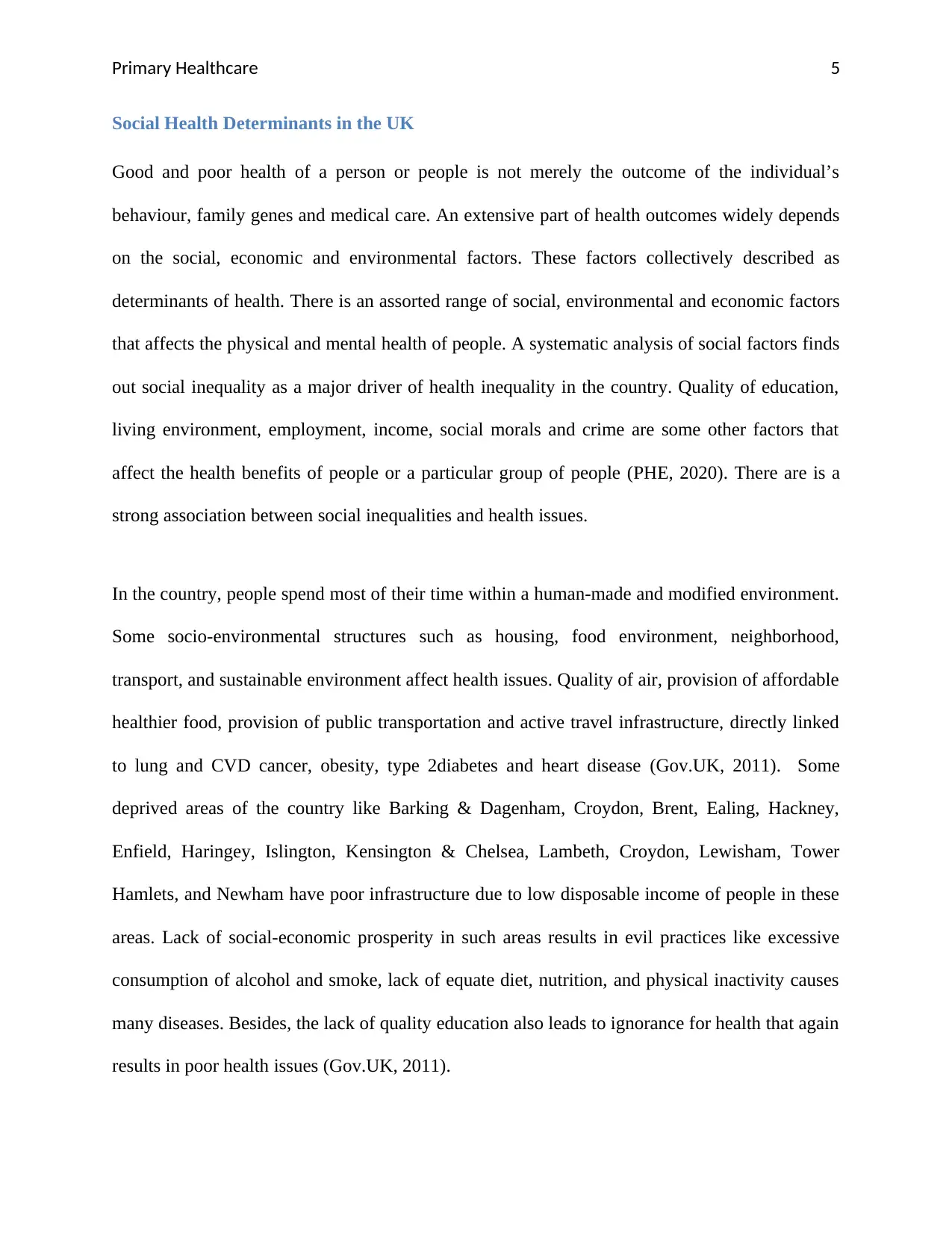
Primary Healthcare 5
Social Health Determinants in the UK
Good and poor health of a person or people is not merely the outcome of the individual’s
behaviour, family genes and medical care. An extensive part of health outcomes widely depends
on the social, economic and environmental factors. These factors collectively described as
determinants of health. There is an assorted range of social, environmental and economic factors
that affects the physical and mental health of people. A systematic analysis of social factors finds
out social inequality as a major driver of health inequality in the country. Quality of education,
living environment, employment, income, social morals and crime are some other factors that
affect the health benefits of people or a particular group of people (PHE, 2020). There are is a
strong association between social inequalities and health issues.
In the country, people spend most of their time within a human-made and modified environment.
Some socio-environmental structures such as housing, food environment, neighborhood,
transport, and sustainable environment affect health issues. Quality of air, provision of affordable
healthier food, provision of public transportation and active travel infrastructure, directly linked
to lung and CVD cancer, obesity, type 2diabetes and heart disease (Gov.UK, 2011). Some
deprived areas of the country like Barking & Dagenham, Croydon, Brent, Ealing, Hackney,
Enfield, Haringey, Islington, Kensington & Chelsea, Lambeth, Croydon, Lewisham, Tower
Hamlets, and Newham have poor infrastructure due to low disposable income of people in these
areas. Lack of social-economic prosperity in such areas results in evil practices like excessive
consumption of alcohol and smoke, lack of equate diet, nutrition, and physical inactivity causes
many diseases. Besides, the lack of quality education also leads to ignorance for health that again
results in poor health issues (Gov.UK, 2011).
Social Health Determinants in the UK
Good and poor health of a person or people is not merely the outcome of the individual’s
behaviour, family genes and medical care. An extensive part of health outcomes widely depends
on the social, economic and environmental factors. These factors collectively described as
determinants of health. There is an assorted range of social, environmental and economic factors
that affects the physical and mental health of people. A systematic analysis of social factors finds
out social inequality as a major driver of health inequality in the country. Quality of education,
living environment, employment, income, social morals and crime are some other factors that
affect the health benefits of people or a particular group of people (PHE, 2020). There are is a
strong association between social inequalities and health issues.
In the country, people spend most of their time within a human-made and modified environment.
Some socio-environmental structures such as housing, food environment, neighborhood,
transport, and sustainable environment affect health issues. Quality of air, provision of affordable
healthier food, provision of public transportation and active travel infrastructure, directly linked
to lung and CVD cancer, obesity, type 2diabetes and heart disease (Gov.UK, 2011). Some
deprived areas of the country like Barking & Dagenham, Croydon, Brent, Ealing, Hackney,
Enfield, Haringey, Islington, Kensington & Chelsea, Lambeth, Croydon, Lewisham, Tower
Hamlets, and Newham have poor infrastructure due to low disposable income of people in these
areas. Lack of social-economic prosperity in such areas results in evil practices like excessive
consumption of alcohol and smoke, lack of equate diet, nutrition, and physical inactivity causes
many diseases. Besides, the lack of quality education also leads to ignorance for health that again
results in poor health issues (Gov.UK, 2011).
⊘ This is a preview!⊘
Do you want full access?
Subscribe today to unlock all pages.

Trusted by 1+ million students worldwide
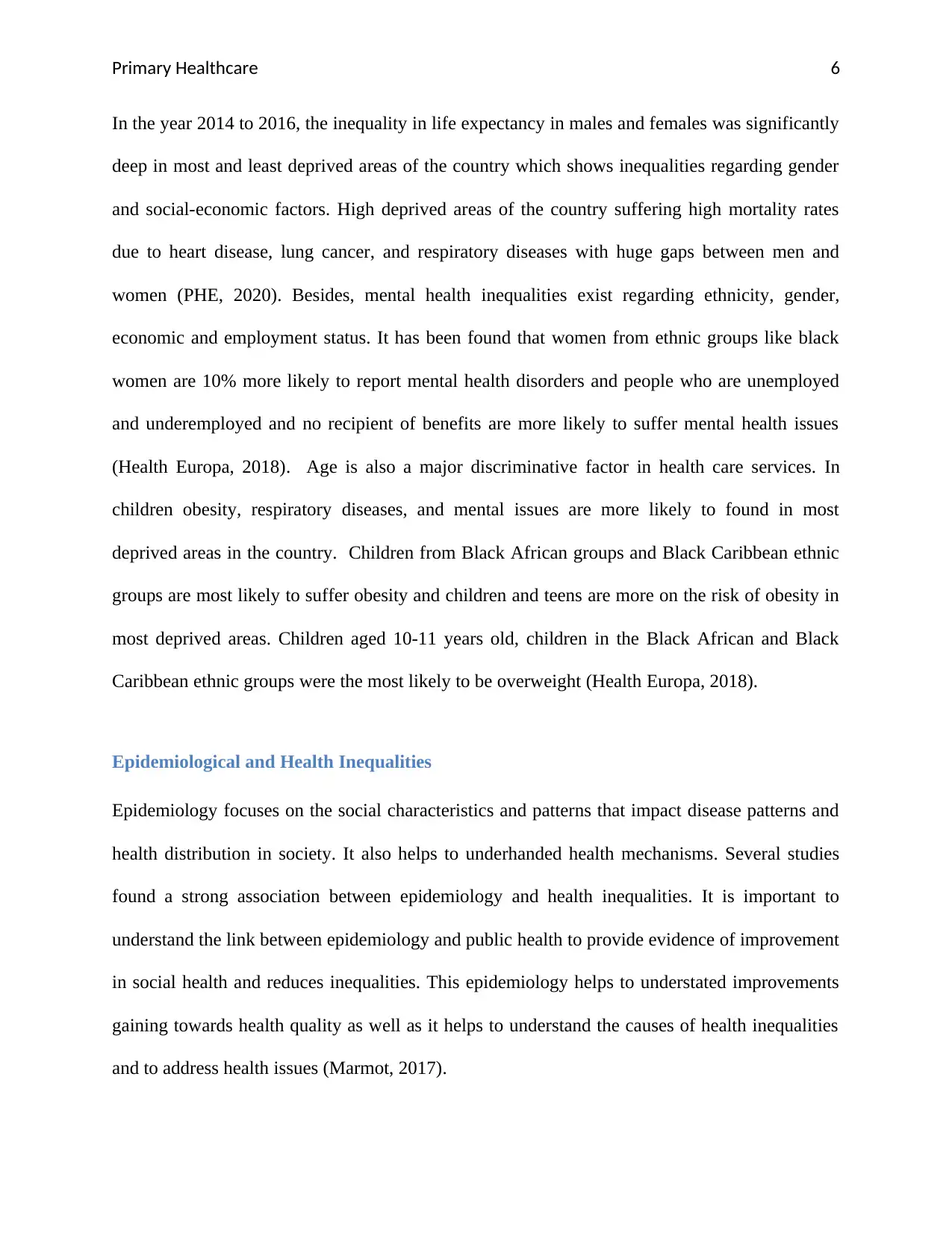
Primary Healthcare 6
In the year 2014 to 2016, the inequality in life expectancy in males and females was significantly
deep in most and least deprived areas of the country which shows inequalities regarding gender
and social-economic factors. High deprived areas of the country suffering high mortality rates
due to heart disease, lung cancer, and respiratory diseases with huge gaps between men and
women (PHE, 2020). Besides, mental health inequalities exist regarding ethnicity, gender,
economic and employment status. It has been found that women from ethnic groups like black
women are 10% more likely to report mental health disorders and people who are unemployed
and underemployed and no recipient of benefits are more likely to suffer mental health issues
(Health Europa, 2018). Age is also a major discriminative factor in health care services. In
children obesity, respiratory diseases, and mental issues are more likely to found in most
deprived areas in the country. Children from Black African groups and Black Caribbean ethnic
groups are most likely to suffer obesity and children and teens are more on the risk of obesity in
most deprived areas. Children aged 10-11 years old, children in the Black African and Black
Caribbean ethnic groups were the most likely to be overweight (Health Europa, 2018).
Epidemiological and Health Inequalities
Epidemiology focuses on the social characteristics and patterns that impact disease patterns and
health distribution in society. It also helps to underhanded health mechanisms. Several studies
found a strong association between epidemiology and health inequalities. It is important to
understand the link between epidemiology and public health to provide evidence of improvement
in social health and reduces inequalities. This epidemiology helps to understated improvements
gaining towards health quality as well as it helps to understand the causes of health inequalities
and to address health issues (Marmot, 2017).
In the year 2014 to 2016, the inequality in life expectancy in males and females was significantly
deep in most and least deprived areas of the country which shows inequalities regarding gender
and social-economic factors. High deprived areas of the country suffering high mortality rates
due to heart disease, lung cancer, and respiratory diseases with huge gaps between men and
women (PHE, 2020). Besides, mental health inequalities exist regarding ethnicity, gender,
economic and employment status. It has been found that women from ethnic groups like black
women are 10% more likely to report mental health disorders and people who are unemployed
and underemployed and no recipient of benefits are more likely to suffer mental health issues
(Health Europa, 2018). Age is also a major discriminative factor in health care services. In
children obesity, respiratory diseases, and mental issues are more likely to found in most
deprived areas in the country. Children from Black African groups and Black Caribbean ethnic
groups are most likely to suffer obesity and children and teens are more on the risk of obesity in
most deprived areas. Children aged 10-11 years old, children in the Black African and Black
Caribbean ethnic groups were the most likely to be overweight (Health Europa, 2018).
Epidemiological and Health Inequalities
Epidemiology focuses on the social characteristics and patterns that impact disease patterns and
health distribution in society. It also helps to underhanded health mechanisms. Several studies
found a strong association between epidemiology and health inequalities. It is important to
understand the link between epidemiology and public health to provide evidence of improvement
in social health and reduces inequalities. This epidemiology helps to understated improvements
gaining towards health quality as well as it helps to understand the causes of health inequalities
and to address health issues (Marmot, 2017).
Paraphrase This Document
Need a fresh take? Get an instant paraphrase of this document with our AI Paraphraser
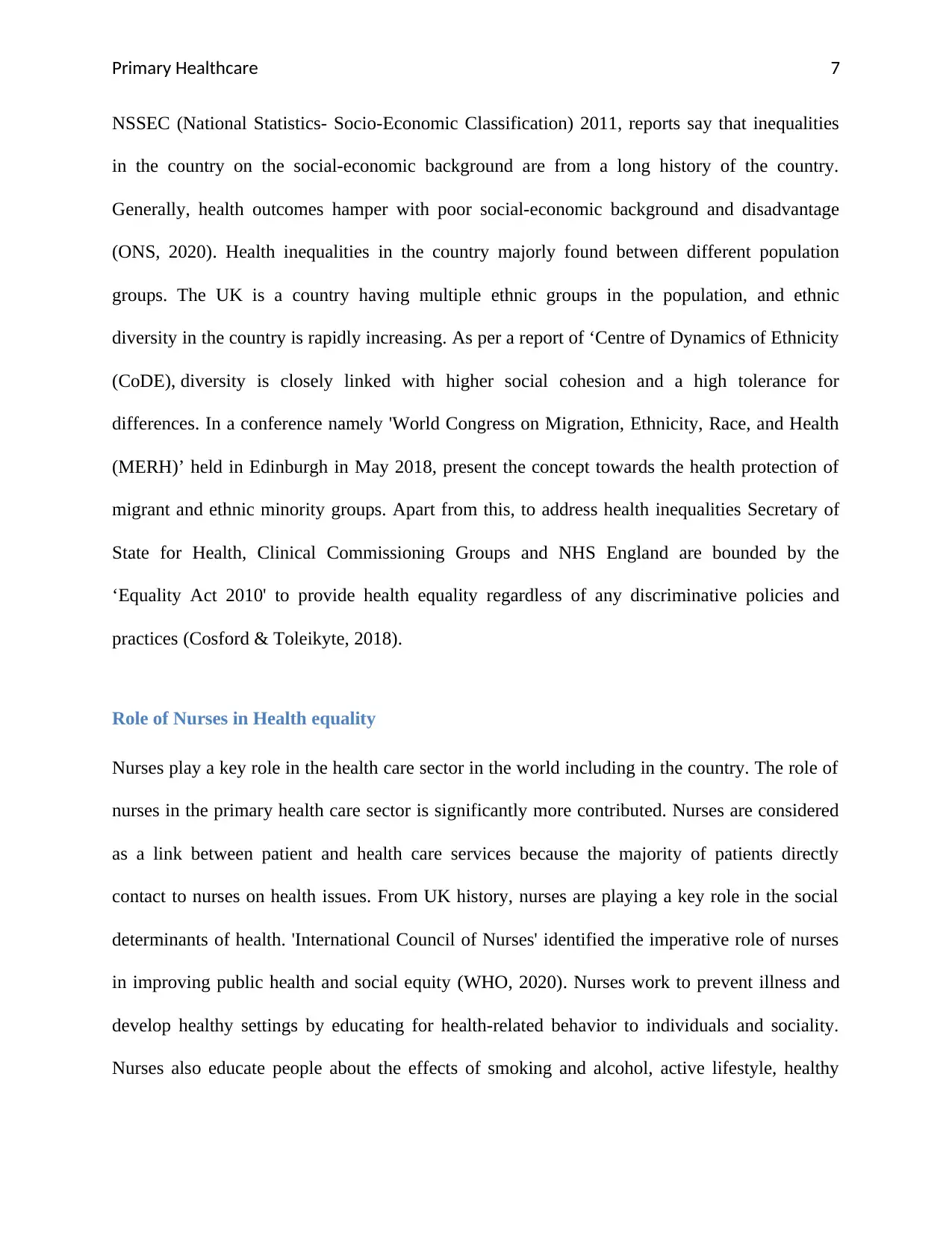
Primary Healthcare 7
NSSEC (National Statistics- Socio-Economic Classification) 2011, reports say that inequalities
in the country on the social-economic background are from a long history of the country.
Generally, health outcomes hamper with poor social-economic background and disadvantage
(ONS, 2020). Health inequalities in the country majorly found between different population
groups. The UK is a country having multiple ethnic groups in the population, and ethnic
diversity in the country is rapidly increasing. As per a report of ‘Centre of Dynamics of Ethnicity
(CoDE), diversity is closely linked with higher social cohesion and a high tolerance for
differences. In a conference namely 'World Congress on Migration, Ethnicity, Race, and Health
(MERH)’ held in Edinburgh in May 2018, present the concept towards the health protection of
migrant and ethnic minority groups. Apart from this, to address health inequalities Secretary of
State for Health, Clinical Commissioning Groups and NHS England are bounded by the
‘Equality Act 2010' to provide health equality regardless of any discriminative policies and
practices (Cosford & Toleikyte, 2018).
Role of Nurses in Health equality
Nurses play a key role in the health care sector in the world including in the country. The role of
nurses in the primary health care sector is significantly more contributed. Nurses are considered
as a link between patient and health care services because the majority of patients directly
contact to nurses on health issues. From UK history, nurses are playing a key role in the social
determinants of health. 'International Council of Nurses' identified the imperative role of nurses
in improving public health and social equity (WHO, 2020). Nurses work to prevent illness and
develop healthy settings by educating for health-related behavior to individuals and sociality.
Nurses also educate people about the effects of smoking and alcohol, active lifestyle, healthy
NSSEC (National Statistics- Socio-Economic Classification) 2011, reports say that inequalities
in the country on the social-economic background are from a long history of the country.
Generally, health outcomes hamper with poor social-economic background and disadvantage
(ONS, 2020). Health inequalities in the country majorly found between different population
groups. The UK is a country having multiple ethnic groups in the population, and ethnic
diversity in the country is rapidly increasing. As per a report of ‘Centre of Dynamics of Ethnicity
(CoDE), diversity is closely linked with higher social cohesion and a high tolerance for
differences. In a conference namely 'World Congress on Migration, Ethnicity, Race, and Health
(MERH)’ held in Edinburgh in May 2018, present the concept towards the health protection of
migrant and ethnic minority groups. Apart from this, to address health inequalities Secretary of
State for Health, Clinical Commissioning Groups and NHS England are bounded by the
‘Equality Act 2010' to provide health equality regardless of any discriminative policies and
practices (Cosford & Toleikyte, 2018).
Role of Nurses in Health equality
Nurses play a key role in the health care sector in the world including in the country. The role of
nurses in the primary health care sector is significantly more contributed. Nurses are considered
as a link between patient and health care services because the majority of patients directly
contact to nurses on health issues. From UK history, nurses are playing a key role in the social
determinants of health. 'International Council of Nurses' identified the imperative role of nurses
in improving public health and social equity (WHO, 2020). Nurses work to prevent illness and
develop healthy settings by educating for health-related behavior to individuals and sociality.
Nurses also educate people about the effects of smoking and alcohol, active lifestyle, healthy
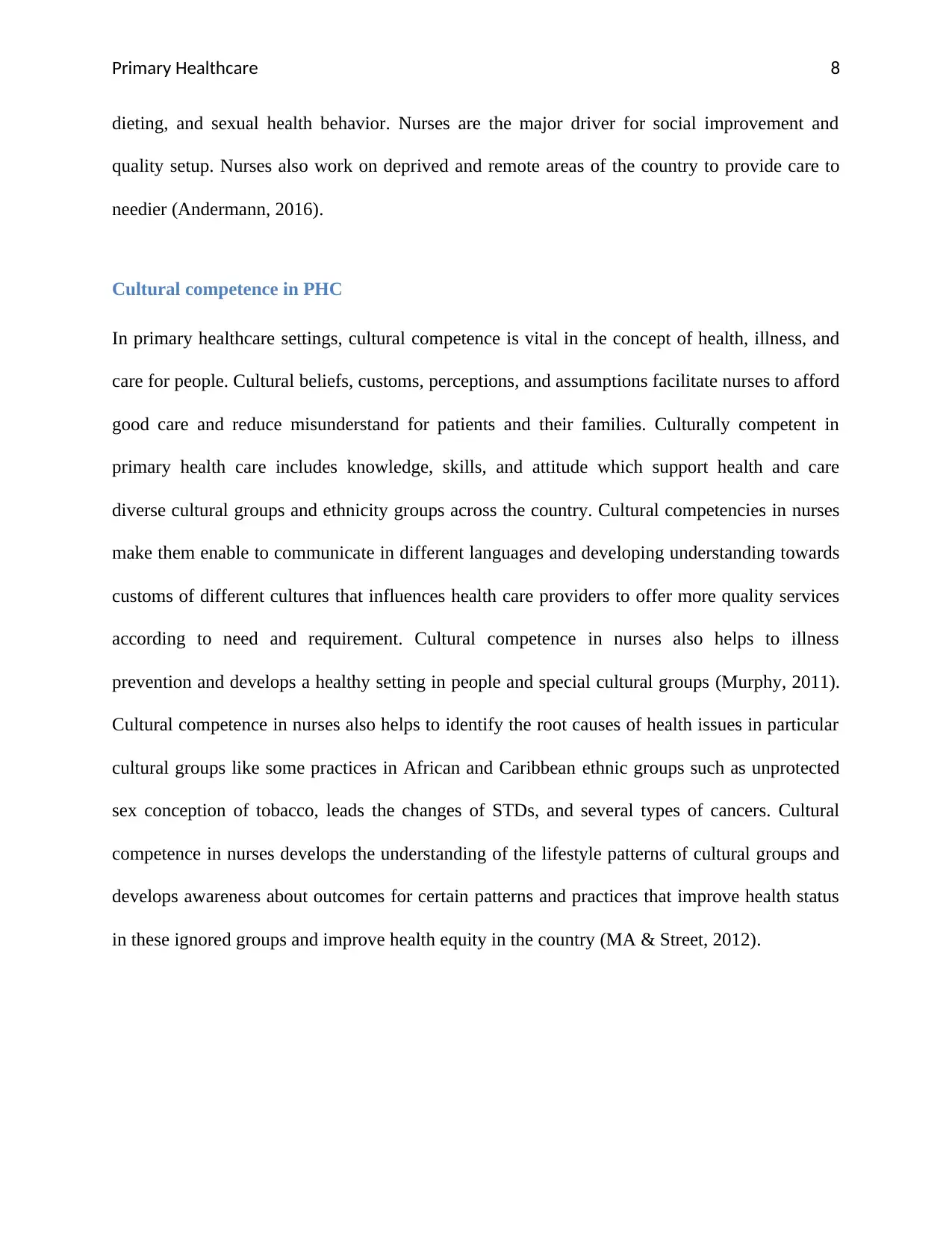
Primary Healthcare 8
dieting, and sexual health behavior. Nurses are the major driver for social improvement and
quality setup. Nurses also work on deprived and remote areas of the country to provide care to
needier (Andermann, 2016).
Cultural competence in PHC
In primary healthcare settings, cultural competence is vital in the concept of health, illness, and
care for people. Cultural beliefs, customs, perceptions, and assumptions facilitate nurses to afford
good care and reduce misunderstand for patients and their families. Culturally competent in
primary health care includes knowledge, skills, and attitude which support health and care
diverse cultural groups and ethnicity groups across the country. Cultural competencies in nurses
make them enable to communicate in different languages and developing understanding towards
customs of different cultures that influences health care providers to offer more quality services
according to need and requirement. Cultural competence in nurses also helps to illness
prevention and develops a healthy setting in people and special cultural groups (Murphy, 2011).
Cultural competence in nurses also helps to identify the root causes of health issues in particular
cultural groups like some practices in African and Caribbean ethnic groups such as unprotected
sex conception of tobacco, leads the changes of STDs, and several types of cancers. Cultural
competence in nurses develops the understanding of the lifestyle patterns of cultural groups and
develops awareness about outcomes for certain patterns and practices that improve health status
in these ignored groups and improve health equity in the country (MA & Street, 2012).
dieting, and sexual health behavior. Nurses are the major driver for social improvement and
quality setup. Nurses also work on deprived and remote areas of the country to provide care to
needier (Andermann, 2016).
Cultural competence in PHC
In primary healthcare settings, cultural competence is vital in the concept of health, illness, and
care for people. Cultural beliefs, customs, perceptions, and assumptions facilitate nurses to afford
good care and reduce misunderstand for patients and their families. Culturally competent in
primary health care includes knowledge, skills, and attitude which support health and care
diverse cultural groups and ethnicity groups across the country. Cultural competencies in nurses
make them enable to communicate in different languages and developing understanding towards
customs of different cultures that influences health care providers to offer more quality services
according to need and requirement. Cultural competence in nurses also helps to illness
prevention and develops a healthy setting in people and special cultural groups (Murphy, 2011).
Cultural competence in nurses also helps to identify the root causes of health issues in particular
cultural groups like some practices in African and Caribbean ethnic groups such as unprotected
sex conception of tobacco, leads the changes of STDs, and several types of cancers. Cultural
competence in nurses develops the understanding of the lifestyle patterns of cultural groups and
develops awareness about outcomes for certain patterns and practices that improve health status
in these ignored groups and improve health equity in the country (MA & Street, 2012).
⊘ This is a preview!⊘
Do you want full access?
Subscribe today to unlock all pages.

Trusted by 1+ million students worldwide
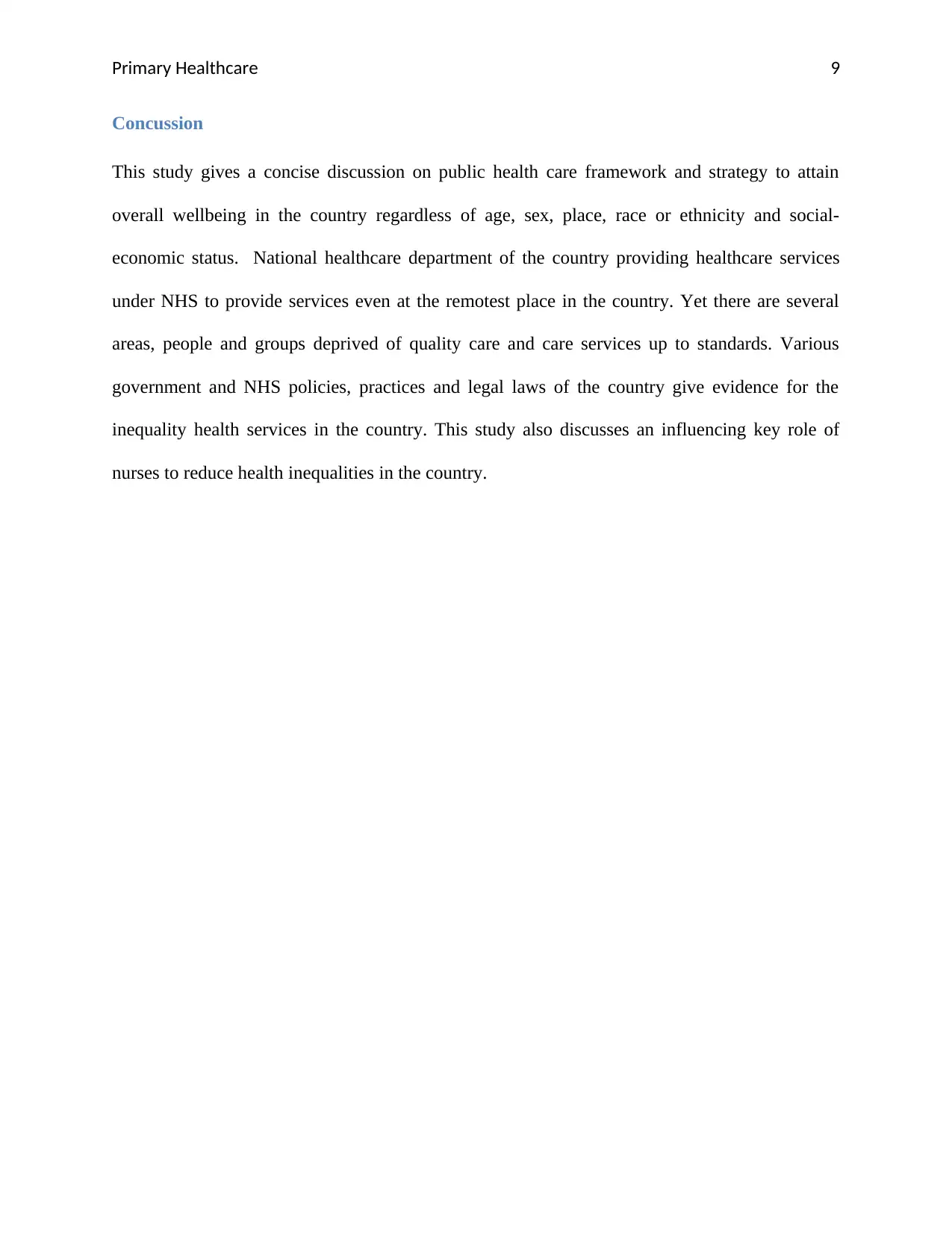
Primary Healthcare 9
Concussion
This study gives a concise discussion on public health care framework and strategy to attain
overall wellbeing in the country regardless of age, sex, place, race or ethnicity and social-
economic status. National healthcare department of the country providing healthcare services
under NHS to provide services even at the remotest place in the country. Yet there are several
areas, people and groups deprived of quality care and care services up to standards. Various
government and NHS policies, practices and legal laws of the country give evidence for the
inequality health services in the country. This study also discusses an influencing key role of
nurses to reduce health inequalities in the country.
Concussion
This study gives a concise discussion on public health care framework and strategy to attain
overall wellbeing in the country regardless of age, sex, place, race or ethnicity and social-
economic status. National healthcare department of the country providing healthcare services
under NHS to provide services even at the remotest place in the country. Yet there are several
areas, people and groups deprived of quality care and care services up to standards. Various
government and NHS policies, practices and legal laws of the country give evidence for the
inequality health services in the country. This study also discusses an influencing key role of
nurses to reduce health inequalities in the country.
Paraphrase This Document
Need a fresh take? Get an instant paraphrase of this document with our AI Paraphraser
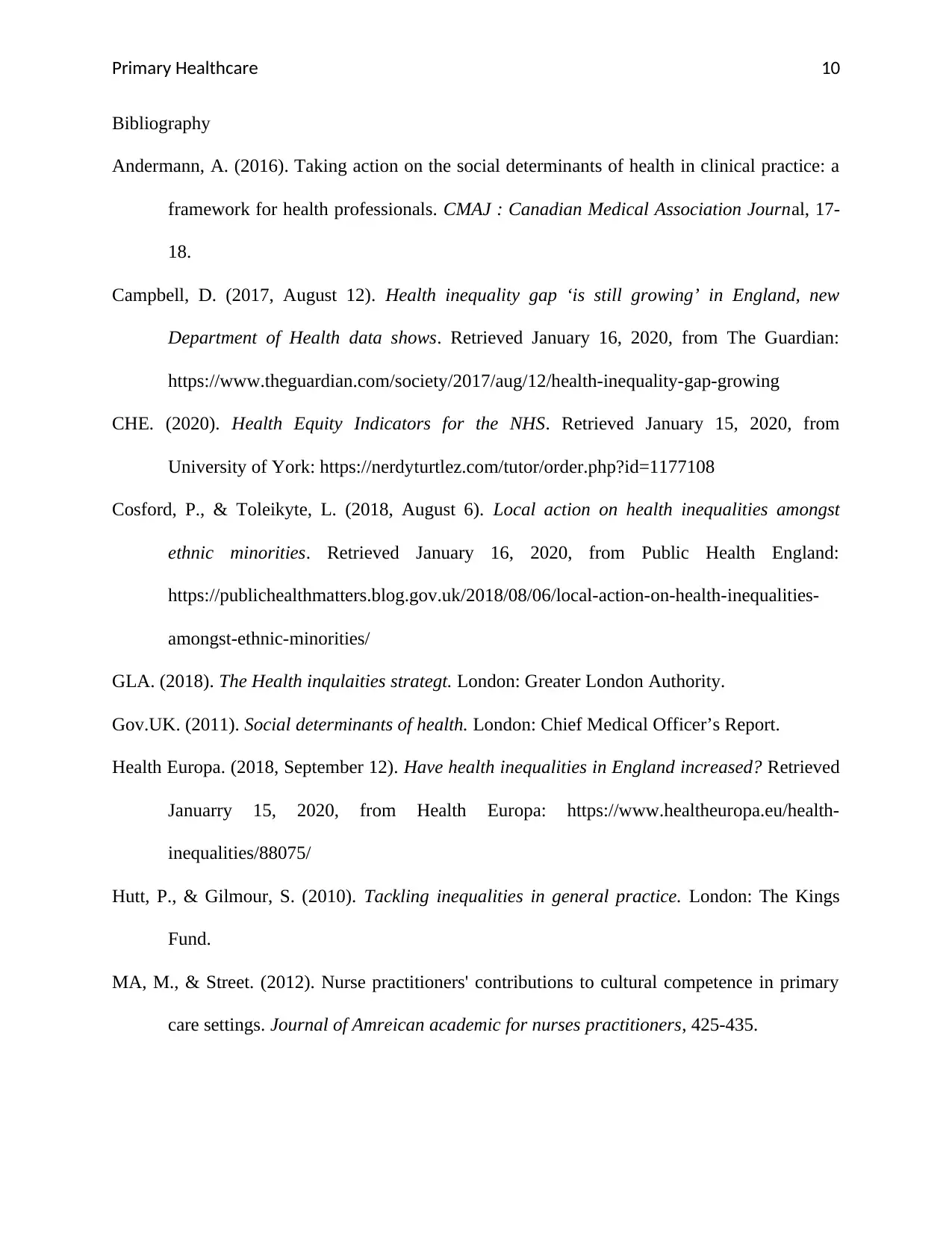
Primary Healthcare 10
Bibliography
Andermann, A. (2016). Taking action on the social determinants of health in clinical practice: a
framework for health professionals. CMAJ : Canadian Medical Association Journal, 17-
18.
Campbell, D. (2017, August 12). Health inequality gap ‘is still growing’ in England, new
Department of Health data shows. Retrieved January 16, 2020, from The Guardian:
https://www.theguardian.com/society/2017/aug/12/health-inequality-gap-growing
CHE. (2020). Health Equity Indicators for the NHS. Retrieved January 15, 2020, from
University of York: https://nerdyturtlez.com/tutor/order.php?id=1177108
Cosford, P., & Toleikyte, L. (2018, August 6). Local action on health inequalities amongst
ethnic minorities. Retrieved January 16, 2020, from Public Health England:
https://publichealthmatters.blog.gov.uk/2018/08/06/local-action-on-health-inequalities-
amongst-ethnic-minorities/
GLA. (2018). The Health inqulaities strategt. London: Greater London Authority.
Gov.UK. (2011). Social determinants of health. London: Chief Medical Officer’s Report.
Health Europa. (2018, September 12). Have health inequalities in England increased? Retrieved
Januarry 15, 2020, from Health Europa: https://www.healtheuropa.eu/health-
inequalities/88075/
Hutt, P., & Gilmour, S. (2010). Tackling inequalities in general practice. London: The Kings
Fund.
MA, M., & Street. (2012). Nurse practitioners' contributions to cultural competence in primary
care settings. Journal of Amreican academic for nurses practitioners, 425-435.
Bibliography
Andermann, A. (2016). Taking action on the social determinants of health in clinical practice: a
framework for health professionals. CMAJ : Canadian Medical Association Journal, 17-
18.
Campbell, D. (2017, August 12). Health inequality gap ‘is still growing’ in England, new
Department of Health data shows. Retrieved January 16, 2020, from The Guardian:
https://www.theguardian.com/society/2017/aug/12/health-inequality-gap-growing
CHE. (2020). Health Equity Indicators for the NHS. Retrieved January 15, 2020, from
University of York: https://nerdyturtlez.com/tutor/order.php?id=1177108
Cosford, P., & Toleikyte, L. (2018, August 6). Local action on health inequalities amongst
ethnic minorities. Retrieved January 16, 2020, from Public Health England:
https://publichealthmatters.blog.gov.uk/2018/08/06/local-action-on-health-inequalities-
amongst-ethnic-minorities/
GLA. (2018). The Health inqulaities strategt. London: Greater London Authority.
Gov.UK. (2011). Social determinants of health. London: Chief Medical Officer’s Report.
Health Europa. (2018, September 12). Have health inequalities in England increased? Retrieved
Januarry 15, 2020, from Health Europa: https://www.healtheuropa.eu/health-
inequalities/88075/
Hutt, P., & Gilmour, S. (2010). Tackling inequalities in general practice. London: The Kings
Fund.
MA, M., & Street. (2012). Nurse practitioners' contributions to cultural competence in primary
care settings. Journal of Amreican academic for nurses practitioners, 425-435.
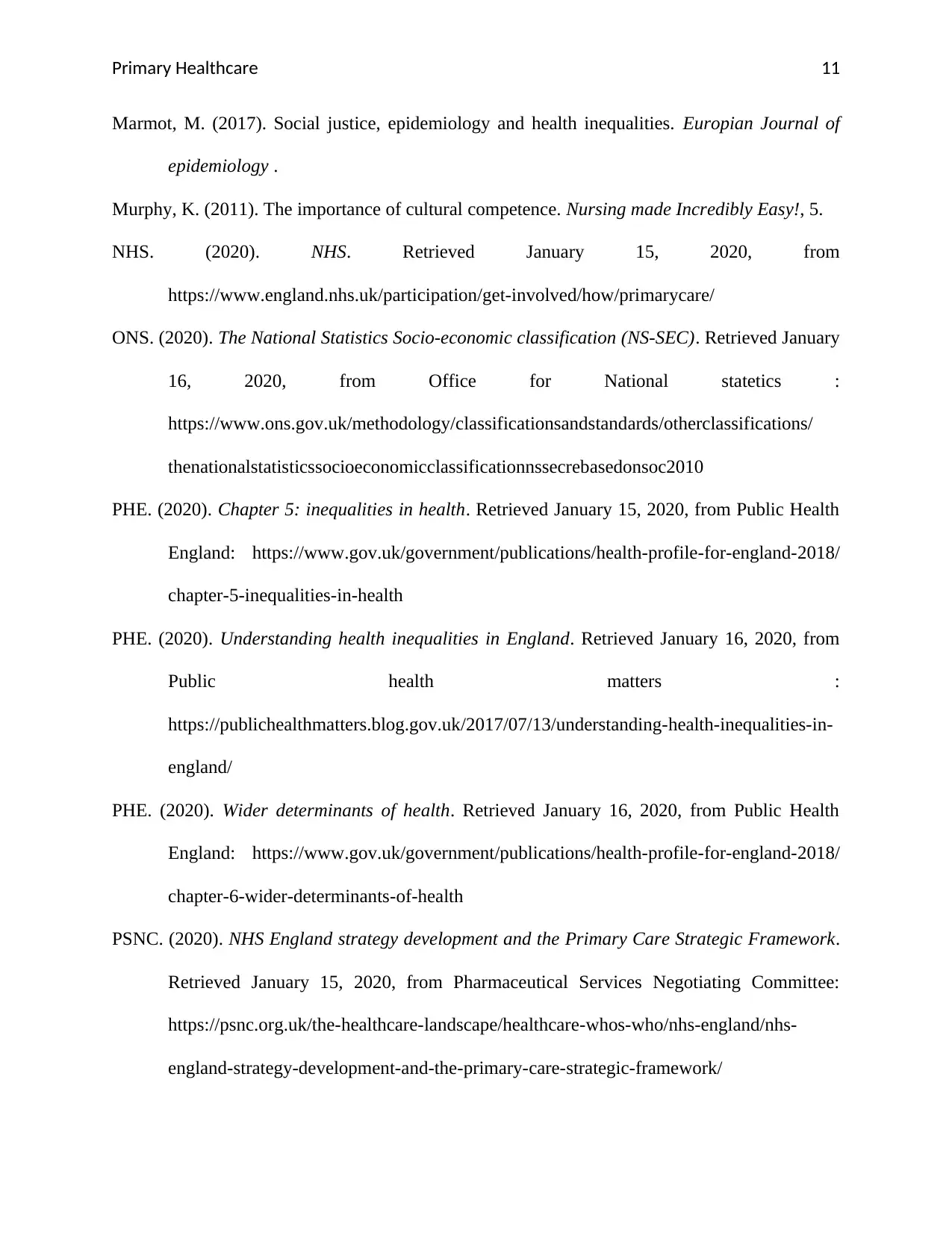
Primary Healthcare 11
Marmot, M. (2017). Social justice, epidemiology and health inequalities. Europian Journal of
epidemiology .
Murphy, K. (2011). The importance of cultural competence. Nursing made Incredibly Easy!, 5.
NHS. (2020). NHS. Retrieved January 15, 2020, from
https://www.england.nhs.uk/participation/get-involved/how/primarycare/
ONS. (2020). The National Statistics Socio-economic classification (NS-SEC). Retrieved January
16, 2020, from Office for National statetics :
https://www.ons.gov.uk/methodology/classificationsandstandards/otherclassifications/
thenationalstatisticssocioeconomicclassificationnssecrebasedonsoc2010
PHE. (2020). Chapter 5: inequalities in health. Retrieved January 15, 2020, from Public Health
England: https://www.gov.uk/government/publications/health-profile-for-england-2018/
chapter-5-inequalities-in-health
PHE. (2020). Understanding health inequalities in England. Retrieved January 16, 2020, from
Public health matters :
https://publichealthmatters.blog.gov.uk/2017/07/13/understanding-health-inequalities-in-
england/
PHE. (2020). Wider determinants of health. Retrieved January 16, 2020, from Public Health
England: https://www.gov.uk/government/publications/health-profile-for-england-2018/
chapter-6-wider-determinants-of-health
PSNC. (2020). NHS England strategy development and the Primary Care Strategic Framework.
Retrieved January 15, 2020, from Pharmaceutical Services Negotiating Committee:
https://psnc.org.uk/the-healthcare-landscape/healthcare-whos-who/nhs-england/nhs-
england-strategy-development-and-the-primary-care-strategic-framework/
Marmot, M. (2017). Social justice, epidemiology and health inequalities. Europian Journal of
epidemiology .
Murphy, K. (2011). The importance of cultural competence. Nursing made Incredibly Easy!, 5.
NHS. (2020). NHS. Retrieved January 15, 2020, from
https://www.england.nhs.uk/participation/get-involved/how/primarycare/
ONS. (2020). The National Statistics Socio-economic classification (NS-SEC). Retrieved January
16, 2020, from Office for National statetics :
https://www.ons.gov.uk/methodology/classificationsandstandards/otherclassifications/
thenationalstatisticssocioeconomicclassificationnssecrebasedonsoc2010
PHE. (2020). Chapter 5: inequalities in health. Retrieved January 15, 2020, from Public Health
England: https://www.gov.uk/government/publications/health-profile-for-england-2018/
chapter-5-inequalities-in-health
PHE. (2020). Understanding health inequalities in England. Retrieved January 16, 2020, from
Public health matters :
https://publichealthmatters.blog.gov.uk/2017/07/13/understanding-health-inequalities-in-
england/
PHE. (2020). Wider determinants of health. Retrieved January 16, 2020, from Public Health
England: https://www.gov.uk/government/publications/health-profile-for-england-2018/
chapter-6-wider-determinants-of-health
PSNC. (2020). NHS England strategy development and the Primary Care Strategic Framework.
Retrieved January 15, 2020, from Pharmaceutical Services Negotiating Committee:
https://psnc.org.uk/the-healthcare-landscape/healthcare-whos-who/nhs-england/nhs-
england-strategy-development-and-the-primary-care-strategic-framework/
⊘ This is a preview!⊘
Do you want full access?
Subscribe today to unlock all pages.

Trusted by 1+ million students worldwide
1 out of 13
Related Documents
Your All-in-One AI-Powered Toolkit for Academic Success.
+13062052269
info@desklib.com
Available 24*7 on WhatsApp / Email
![[object Object]](/_next/static/media/star-bottom.7253800d.svg)
Unlock your academic potential
Copyright © 2020–2025 A2Z Services. All Rights Reserved. Developed and managed by ZUCOL.





